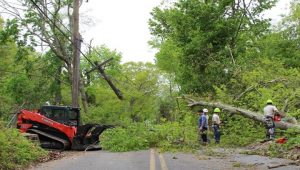Hamden Tornado May 15, 2018

While our region is less prone to extreme weather than many, warming waters and changing currents are fueling stronger storms. Many New York and Connecticut residents have experienced flooding, power outages, and high winds over the last several years. On May 15, 2018, south central Connecticut was hit with two tornados. Our development writer, Willow Sirch, relates her experience with the storm.
My husband and I carpool to and from work; when we left for home Tuesday night, we were expecting nothing more than a passing thunderstorm. A few minutes into the drive, the sky turned yellow and it began to rain hard, pounding on the roof of our car. We received an automated text that our power was out at home. We wanted hot food for dinner, so called a restaurant near home to order. The owner answered the phone in tears. “We’ve just been hit by a tornado,” she sobbed. “We won’t be up and running for days.” Then it began to hail. Our neighbors texted that our house and garage were OK, but that there were trees down in our backyard. We debated whether to go on. Then the hail stopped and rain slowed to a shower, so with pets at home, we kept on.
There are about 15 different “back road” routes to get to our house. That night, we tried every one. Each was blocked by massive trees and enormous tangled webs of downed electrical wires. It looked like a war zone. Traffic was dense, with rush hour cars trying this way, then that, and abruptly heading back the way they had come. Meanwhile, we arranged for our daughter, on the other side of town, to stay with friends, since driving home was not an option. That was just before we lost cell service.
Not only was every road blocked in our suburban neighborhood, but in people’s yards, large trees were snapped off mid-trunk, others uprooted, their root balls pathetically exposed. Roofs were crushed, cars smashed, the side of one home was torn open, revealing bedrooms, furniture, clothing spilling out. People were out in their yards with slightly dazed expressions as if they couldn’t quite believe the destruction.
As dusk approached, we parked our car in an elementary school about two miles from the house, along with dozens of others who couldn’t get home by car, and started trekking down the nearest street. Gigantic oaks, maples, and other hardwood trees had fallen across the road about every 20 or 30 feet. Some were suspended precariously on stretched electrical wires. Telephone poles, transformers, and street lights lay on the pavement. We circumnavigated the mess in the wet drizzle, slogging across yards, through woods, and over swollen streams. It took us an hour to reach our backyard, which was scarcely recognizable. Trees had collapsed into other trees. One was lying on our neighbor’s roof. We were thankful that our house and garage were spared. Many were not so lucky. Without any forewarning of severe weather, many families came home to a squashed car or demolished roof and darkness.
The next day, a home in our neighborhood was condemned. We would be without power for five days, despite crews working around the clock. A school two houses away was set up as an aid station with charging facilities and fresh water—since most homes where we live have electrically-powered wells.
The destruction and power loss seemed all too familiar in our part of the world, given the nor’easter of October 2011, Hurricane Sandy in 2012, and the nor’easter this past March when we were again without power for five days during frigid temperatures.
While federal politicians dither about climate change, Connecticut legislators have taken some practical actions: using grant funding to make some sewage treatment plants more storm-resilient and to create microgrids, mini-power generation plants that operate to supply power to nearby buildings even when the electric grid goes down. But it’s not nearly enough. We must demand bolder action from our elected officials: more aggressive investment in efficiency, quicker adoption of clean-driving electric vehicles and public transit, and rapid expansion of solar and offshore wind energy to replace polluting fossil fuels. Otherwise, storms will keep getting stronger and our communities will suffer.
